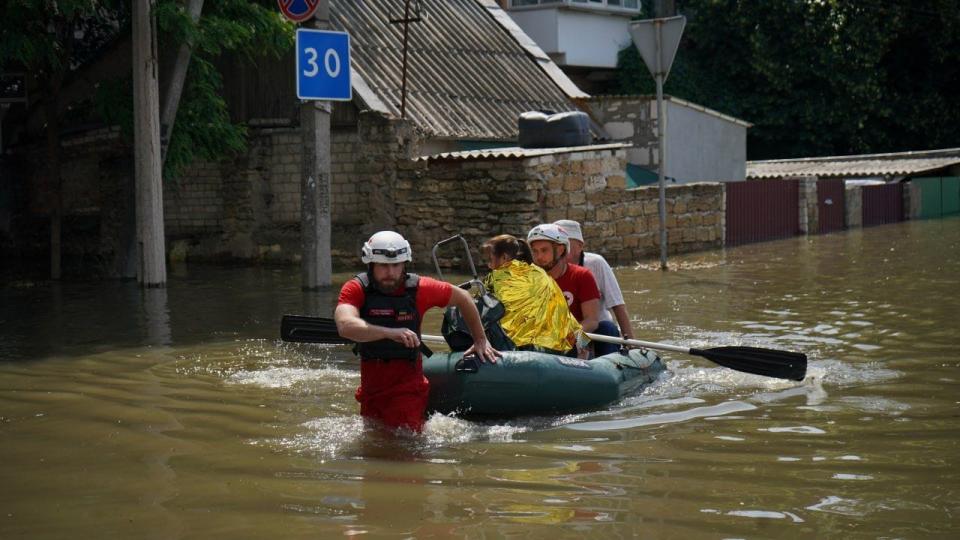Weeks after a dam was blown up in Ukraine, the collapse continues to cause strife
Seven weeks after a dam collapsed in a Russian-controlled area of Kherson province in southern Ukraine, thousands of Ukrainians are still struggling to access clean water and aid workers say the situation is dire.
Ukrainian health officials have detected cholera-like vibrio bacteria in the cities of Mykolaiv and in Odesa, key Black Sea port towns near the dam that ship grain and are in the midst of repeated Russian bombings in the nearly 18-month-old war. Russia is targeting key grain infrastructure as part of its declared "retribution" for the attack on a critical 12-mile bridge that connects the occupied Crimean Peninsula with southern Russia.
"This is just another compounding problem they're dealing with. We are trying to ramp up our resources as fast as we can," said Jaime Wah, a Red Cross health coordinator on the front lines in southern Ukraine, about the water crisis and subsequent fallout. Red Cross workers have distributed more than 26,000 liters of bottled water in the area since the dam collapsed.
Ukraine and Russia initially blamed each other for blowing up the dam in early June. The Washington, D.C.-based think tank Institute for the Study of War determined that Russia was probably behind the blast that reportedly killed more than 50 people.
Experts, including Dr. Jarno Habicht, the World Health Organization's Ukrainian representative, believe the environmental impact of the dam collapse could last for generations.
"The situation is devastating, especially in those settlements which have flooded, and that is why the humanitarian convoys are delivering as much (water and food) as possible," Habicht said. "This is really the new crisis within the overall emergency and war in Ukraine since the invasion."

'An ecological and political disaster'
The dam breach affected dozens of towns along the lower Dnieper River in the Kherson, Mykolaiv and Dnipropetrovsk regions. The flooding forced massive evacuations. Humanitarian aid was initially delivered by foot, then by boat in cities including Kherson and Afanasiivka. Agricultural crops were ruined; dead fish were floating in reservoirs.
Wah said the International Red Cross rescued about 2,000 residents in the area, mostly at-risk elderly and those lacking mobility, whose homes were ravaged by the floodwaters. Many remain in temporary shelters, including schools, colleges and community centers. A huge cleanup is occurring, including pumping out water from ravaged homes, removing tons of debris and collecting whatever residents' personal belongings are salvageable, Red Cross officials said.
"The attack is a massive disaster, a human disaster, an ecological and political disaster," said Peter Gleick, a senior fellow at the Pacific Institute in Oakland, California, who examines how war has impacted water throughout Ukraine.
About 17 different Red Cross teams from across Europe are helping areas affected by the dam's collapse. While resident evacuations are now sporadic, through global donations the teams are distributing food and clothing and supplying drinking water through plastic bottles and water purification units, Wah said.
Other international aid groups, including CARE and USAID, are also providing humanitarian assistance.
"No one entity can do this alone," Wah said. "There's a lot of good intentions and a lot of streamlining. We are all working together."
While all of the aid workers are providing selfless care, they must also be mindful of their physical and mental health, said Dr. Maya Bizri, a disaster psychiatrist who has been on the frontlines in Ukraine training healthcare workers who serve side-by-side with their humanitarian counterparts.
"When everyone is helping out, there's this sensation of cohesion and you put your own feelings aside for the greater good," Bizri said. "But during this highly stressful time, the workers also have to take care of their own well-being in this ongoing war that seems to have no end in sight."
Concerns raised over water-borne outbreaks
WHO officials are raising concerns about hazardous chemicals in the water and potential water-borne outbreaks including cholera, typhoid fever and possibly rodent-borne diseases. Ukrainian health officials say there's been a "significant increase" in pathogens, including E. coli, salmonella, norovirus and rotavirus in the areas affected by the dam's collapse. The "unacceptably poor water quality" prompted health officials to prohibit swimming, fishing and sea market operations in the area.
"Add in stagnant water mixed with sewage and warm water due to the hot temperatures, and it, unfortunately, becomes the perfect breeding ground," said Edgar Zúñiga, a Ukrainian delegate for the American Red Cross based in Budapest, Hungary.
Besides disease, the lack of water will affect acres of farmland used to grow grains and vegetables, which not only affects Ukraine but "the agricultural and food production that the rest of the world depends on," Gleick said.
Scrambling for permanent water supply solutions in southern Ukraine
Meanwhile, the Red Cross keeps supplying tons of bottled water to dam-affected residents, Zúñiga said. There are plans to bring in water distribution trucks with fresh water for household use in Khershon and Mykolaiv until local water systems can be restored. Restoration could take several months, maybe longer, Wah said.
The distribution trucks have taps, allowing residents to store the water in containers. The trucks will continuously arrive from water treatment plants in other Ukrainian regions, Wah said. As a precaution, area Red Cross emergency response workers will be trained in not only distribution but conducting tests to make sure the water meets their internal standards.
"Bottled water is a short-term solution to the bigger problem," Wah said. "The dam will probably never be the same, so, hopefully, these distribution trucks help until a longer-term solution is set up."
This article originally appeared on USA TODAY: Ukraine dam collapse: 'Massive disaster' remains weeks after explosion

